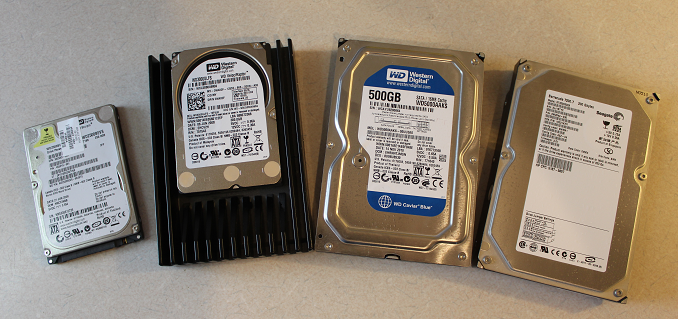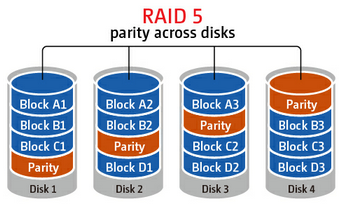Averting Disaster - A Guide To Computer Backups (2014)
by Brett Howse on May 21, 2014 9:00 AM EST- Posted in
- IT Computing
- Mac
- Apple
- Windows
- Cloud Computing
- macOS

Introduction
We all store more and more of our lives in digital form; spreadsheets, résumés, wedding speeches, novels, tax information, schedules, and of course digital photographs and video. All of this data is easy to store, transmit, copy, and share, but how easy is it to get back?
All of this data can be a harsh reminder that computers are not without fault. For years, storage costs have been dropping while at the same time the amount of storage in any one computer has been increasing almost exponentially. We are at a point where a single hard drive can contain multiple terabytes of information, and with a single mishap, lose it all forever. Everyone knows someone who has had the misfortune of having a computer stop working and wanting their information back.
It’s always been possible to safeguard your data, but now it’s not only necessary thanks to the explosion of personal data, it’s also more affordable than ever. When you think of the costs of backing up your data, just remember what it would cost you if you were to ever lose it all. This guide will walk you through saving your data in multiple ways, with the end goal being to have a backup system that is simple, effective, and affordable. In this day and age, you really can have it all.
It’s prudent at this point to define what a backup is, because there are a lot of misconceptions out there which can cause much consternation when the unthinkable happens, and people who thought they were protected find out they were not.
Backups are simply duplicates of data which are archived, and which can be restored to a previous point in time. The key is the data must be duplicated, and you have to be able to go back to an earlier time. Anything that doesn’t meet both of those requirements is not a backup.
As an example, many people trust their data to network storage devices with RAID (Redundant Array of Independent Disks). Without going into the intricacies of various forms of RAID, none of these Network Attached Storage (NAS) devices are any sort of a backup on their own. RAID is designed to protect a system from a hard disk failure and nothing more. Depending on the RAID level, it either duplicates disks, or uses a calculation to create a parity of the data which can be used to calculate the original value of the data if any part of the data is missing from a failed disk. While RAID is an excellent mechanism to keep a system operational in the event of a disk failure, it is not a backup because if a file is changed or deleted, it is instantly updated or removed on all disks, and therefore there is no way to roll back that change. RAID is excellent for use as a file share, and can even be effectively utilized as the target for backups, but it still requires a file backup system if important data is kept on the array.
Another similar example is cloud storage. Properly configured, cloud storage can be a backup target, and different services can even properly perform backups, but the average person with the average Google Drive or OneDrive account can’t copy their files there and hope they are protected. As with RAID, it is a more robust file storage than any single hard drive, but if you delete a file, or copy over another, it can be difficult or impossible to go back to a previous version.
Both RAID and cloud storage suffer from the same problem – you can’t go back to an earlier time, and therefore are not a true backup. True backups will allow you to recover from practically any scenario – fire, flood, theft, equipment failure, or the inevitable user error. This guide will walk you through several methods of performing backups starting at simple and moving up to elaborate systems that will truly protect your data. These methods work for home and business alike, just the type of equipment will likely differ.
There is some common terminology used in backups that should be defined before we start discussing the intricacies of backups:
- Archive Flag: A bit setting on all files which states whether or not the file has been modified since the last time the flag was cleared.
- Full Backup: A backup of all files which resets the archive flag.
- Differential Backup: A backup of all files with the archive flag set, but it does not clear the archive flag.
- Incremental Backup: A backup of all files with the archive flag set which resets the archive flag.
- Image or System Based Backup: A complete disk level backup which would allow you to image a machine back to a previous state.
- Deduplication: A software algorithm which removes all duplicate file parts to reduce the amount of storage required.
- Source Deduplication: removing duplicate file information from files on the client end. This requires more CPU and memory usage on the client, but allows for a much smaller file size to be transferred to the backup target.
- Target Deduplication: removing duplicate file information from files on the target end. This saves client CPU and memory usage, and is used to reduce the amount of storage space required on the backup target.
- Block Level: A backup or system process which accesses a sequence of bytes of data directly on the disk.
- File Level: A backup or system process which accesses files by querying the Operating System for the entire file.
- Versioning: A list of previous versions of a file or folder.
- Recovery Point Objective (RPO): The amount of time since the last backup deemed safe to lose in a disaster scenario. For example, if you perform backups nightly, your RPO would be the previous night’s backups. Anything created in between backups is assumed to be recoverable through other methods, or an acceptable loss.
- Recovery Time Objective (RTO): The amount of time deemed acceptable between the loss of data and the recovery of data. For home use, there’s really no RTO but many commercial companies will have this defined either with in-house IT or with a Service Level Agreement (SLA) to a support company.











133 Comments
View All Comments
gcoupe - Wednesday, May 21, 2014 - link
Well, to be fair WHS 2011 is not yet "defunct". It is in mainstream support until April 2016:http://support.microsoft.com/lifecycle/search/defa...
However, I agree that it is a crying shame that Microsoft has left the home server market to wither on the vine. WHS was a good product. WHS 2011 was not the advance over the original that it should have been, because of Microsoft organizational politics. Still, it was a real bargain at $40. Windows Server Essentials 2012 is too expensive for home users to even consider.
peterfares - Wednesday, May 21, 2014 - link
I agree. I Use Windows Server 2012 R2 because I got a license from DreakSpark but there is absolutely no way I'd consider buying that for home server use. I'd probably just run a client version of Windows and use third party programs to handle backups. It's unfortunate that they removed automatic system image backups from Windows 8.1kmmatney - Wednesday, May 21, 2014 - link
WHS 2011 with Stablebit DrivePool has been working for me. I plan on keeping it a while, but after that I'll just figure out a way to pretty a regular version of Windows on the machine, and third party central backup programs. I also use my WHS server as a Minecraft server, and media server.SirGCal - Wednesday, May 21, 2014 - link
100 GB - $241 TB / $120
10 TB / $1200
20 TB / $2400
300 TB / $3600
Don't you mean 30TB, not 300TB? For Google Drive on 'Consumer Cloud and What I Do' page? If not, then 300TB is for sure the way to go. What a savings...
Brett Howse - Wednesday, May 21, 2014 - link
Yes I did fixed tyvm!Guinpen - Wednesday, May 21, 2014 - link
No mention of options for Linux? Why?Brett Howse - Wednesday, May 21, 2014 - link
I mentioned Crashplan has a Linux client. I don't use Linux on my home computers, and neither do most people, so I didn't discuss it for the most part.wumpus - Thursday, May 22, 2014 - link
I plan on backing up my cousin's windows computer (I owe him one, otherwise highly not recommended). Best I can tell, the way to do this (especially if you have some handy drives that will store the data compressed, but not uncompressed) is to install Linux on some removeable drives (OpenSUSE looks promising, see below) and then use the dd command to copy the windows drive completely as an image to the Linux external drive (this gives you the option to either copy the entire system back (with everything already installed) or to mount the file with -loopback and copy individual files). Note that you will likely want a compressed linux drive (to save space). This looks easiest with btfs (thus Opensuse, and don't forget the forcing option otherwise the compressor will give up before it hits all that empty space). Using this system for incremental backups requires a bit of programming (but is surprisingly easy with pyfuse).Quite frankly, the dd "disk destroyer" command is so famous to get wrong (and thus write empty sectors over what you wanted to back up) that I would be afraid to include step by step instructions in something like this. You have been warned.
It would be nice to see if you could back up with something like Anaconda, especially for free.
peterfares - Wednesday, May 21, 2014 - link
Ah sweet I didn't know there was still a GUI method for doing a system backup in Windows 8.1! I thought you had to use wbadmin. I was wondering why the Windows 8.1 recovery still supported system image restores when I thought there was no way to create a system image without the command line.Anyways for previous versions on Windows 8.1: they're still there! Just the tab is not shown for local drives. If you access a network share you can still see the previous versions of files done with Volume Shadow Copy. Turn on system recovery for all your hard drives (it's on for the system drive as default) and then access your own computer via it's UNC path (\localhost\C$ or whatever other share you want to access). Then when you press properties on folder or file the previous versions tab is present!
Another way to access volume shadow copies of files is to use ShadowExplorer.
peterfares - Wednesday, May 21, 2014 - link
More details http://winhowto.blogspot.com/2012/09/windows-8-how...